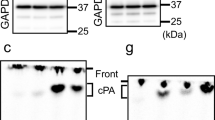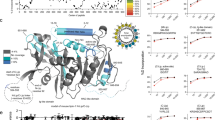Abstract
A mammalian family of lipid hydrolases, designated “patatin-like phospholipase domain containing (PNPLA)” recently has attracted attention. NTE-related esterase (NRE) as a member of PNPLA is an insulin-regulated lysophospholipase with homology to neuropathy target esterase (NTE). Mouse NRE (mNRE) has a predicted amino-terminal transmembrane region (TM), a putative regulatory (R) domain, and a hydrophobic catalytic (C) domain. In the current study, we described the expression of green fluorescent protein (GFP)-tagged constructs of mNRE and mutant proteins lacking the specific protein domains. Esterase assays indicated that neither the TM nor R-domain was essential for mNRE esterase activity, but the TM significantly contributed to its activity. Subcellular distribution showed that mNRE was anchored in ER via its TM domain and that its C-domain was associated with ER. Furthermore, experiments involving proteinase treatment revealed that most of mNRE molecule was exposed on the cytoplasmic face of ER membranes. Collectively, our results for the first time revealed the protein domains, catalytic activity, and subcellular location of mNRE and a simplified model for mNRE was proposed.







Similar content being viewed by others
Abbreviations
- DMEM:
-
Dulbecco’s modified Eagle’s medium
- EDTA:
-
Ethylenediaminetetraacetic acid
- ECL:
-
Enhanced chemiluminescence
- GFP:
-
Green fluorescence protein
- ER:
-
Endoplasmic reticulum
- NEST:
-
NTE esterase activity domain
- NP40:
-
Nonidet P-40
- NTE:
-
Neuropathy target esterase
- NRE:
-
NTE-related esterase
- NREC:
-
The catalytic domain of NRE
- NREN:
-
The N-terminal domain of NRE
- OPIDN:
-
OP-induced delayed neuropathy
- PBS:
-
Phosphate-buffered saline
- PCR:
-
Polymerase chain reaction
- PK:
-
Proteinase K
- PNPLA:
-
Patatin-like phospholipase domain containing
- PV:
-
Phenyl valerate
- RT–PCR:
-
Reverse transcription–PCR
- SDS-PAGE:
-
Sodium dodecyl sulfate-polyacrylamide gel electrophoresis
- TM:
-
Transmembrane
- TX:
-
Triton X-100
References
Kienesberger PC, Oberer M, Lass A et al (2009) Mammalian patatin domain containing proteins: a family with diverse lipolytic activities involved in multiple biological functions. J Lipid Res 50:S63–S68
Vancanneyt G, Sonnewald U, Hofgen R et al (1989) Expression of a patatin-like protein in the anthers of potato and sweet pepper flowers. Plant Cell 1:533–540
Smirnova E, Goldberg EB, Makarova KS et al (2006) ATGL has a key role in lipid droplet/adiposome degradation in mammalian cells. EMBO Rep 7:106–113
Rydel TJ, Williams JM, Krieger E et al (2003) The crystal structure, mutagenesis, and activity studies reveal that patatin is a lipid acyl hydrolase with a Ser-Asp catalytic dyad. Biochemistry 42:6696–6708
Schneider G, Neuberger G, Wildpaner M et al (2006) Application of a sensitive collection heuristic for very large protein families: evolutionary relationship between adipose triglyceride lipase (ATGL) and classic mammalian lipases. BMC Bioinform 7:164
Wilson PA, Gardner SD, Lambie NM et al (2006) Characterization of the human patatin-like phospholipase family. J Lipid Res 47:1940–1949
Lush MJ, Li Y, Read DJ et al (1998) Neuropathy target esterase and a homologous Drosophila neurodegeneration-associated mutant protein contain a novel domain conserved from bacteria to man. Biochem J 332:1–4
Glynn P (2006) A mechanism for organophosphate-induced delayed neuropathy. Toxicol Lett 162:94–97
Quistad GB, Barlow C, Winrow CJ et al (2003) Evidence that mouse brain neuropathy target esterase is a lysophospholipase. Proc Natl Acad Sci USA 100:7983–7987
Zaccheo O, Dinsdale D, Meacock PA et al (2004) Neuropathy target esterase and its yeast homologue degrade phosphatidylcholine to glycerophosphocholine in living cells. J Biol Chem 279:24024–24033
Muhlig-Versen M, da Cruz AB, Tschape JA et al (2005) Loss of Swiss cheese/neuropathy target esterase activity causes disruption of phosphatidylcholine homeostasis and neuronal and glial death in adult Drosophila. J Neurosci 25:2865–2873
Winrow CJ, Hemming ML, Allen DM et al (2003) Loss of neuropathy target esterase in mice links organophosphate exposure to hyperactivity. Nat Genet 33:477–485
Moser M, Li Y, Vaupel K et al (2004) Placental failure and impaired vasculogenesis result in embryonic lethality for neuropathy target esterase-deficient mice. Mol Cell Biol 24:1667–1679
Akassoglou K, Malester B, Xu J (2004) Brain-specific deletion of neuropathy target esterase/swisscheese results in neurodegeneration. Proc Natl Acad Sci USA 101:5075–5080
Xie M, Yang D, Matoney L et al (2003) Rat NTE-related esterase is a membrane-associated protein, hydrolyzes phenyl valerate, and interacts with diisopropylfluorophosphate through a serine catalytic machinery. Arch Biochem Biophys 416:137–146
Chang PA, Long DX, Wu YJ (2007) Molecular cloning and expression of the C-terminal domain of mouse NTE-related esterase. Mol Cell Biochem 306:25–32
Kienesberger PC, Lass A, Preiss-Landl K et al (2008) Identification of an insulin-regulated lysophospholipase with homology to neuropathy target esterase. J Biol Chem 283:5908–5917
Chang PA, Long DX, Sun Q et al (2008) Identification and characterization of a splice variant of the catalytic domain of mouse NTE-related esterase. Gene 417:43–50
Johnson MK (1977) Improved assay of neurotoxic esterase for screening organophosphates for delayed neurotoxicity potential. Arch Toxicol 37:113–115
Lowry OH, Rosebrough NJ, Farr AL et al (1951) Protein measurement with the Folin phenol reagent. J Biol Chem 193:265–275
Chang PA, Wu YJ, Li W et al (2006) Effect of carbamate esters on neurite outgrowth in differentiating human SK-N-SH neuroblastoma cells. Chem Biol Interact 159:65–72
Bradford MM (1976) A rapid and sensitive method for the quantitation of microgram quantities of protein utilizing the principle of protein-dye binding. Anal Biochem 72:248–254
Ou WJ, Bergeron JJ, Li Y et al (1995) Conformational changes induced in the endoplasmic reticulum luminal domain of calnexin by Mg-ATP and Ca2+. J Biol Chem 270:18051–18059
Arnold K, Bordoli L, Kopp J et al (2006) The SWISS-MODEL Workspace: a web-based environment for protein structure homology modelling. Bioinformatics 22:195–201
Wijeyesakere SJ, Richardson RJ, Stuckey JA (2007) Modeling the tertiary structure of the patatin domain of neuropathy target esterase. Protein J 26:165–172
Li Y, Dinsdale D, Glynn P (2003) Protein domains, catalytic activity, and subcellular distribution of neuropathy target esterase in mammalian cells. J Biol Chem 278:8820–8825
Takei K, Mignery GA, Mugnaini E et al (1994) Inositol 1,4,5-trisphosphate receptor causes formation of ER cisternal stacks in transfected fibroblasts and in cerebellar Purkinje cells. Neuron 12:327–342
Ishihara N, Yamashina S, Sakaguchi M et al (1995) Malfolded cytochrome P-450(M1) localized in unusual membrane structures of the endoplasmic reticulum in cultured animal cells. J Biochem 118:397–404
Yamamoto A, Masaki R, Tashiro Y (1996) Formation of crystalloid endoplasmic reticulum in COS cells upon overexpression of microsomal aldehyde dehydrogenase by cDNA transfection. J Cell Sci 109:1727–1738
Snapp EL, Hegde RS, Francolini M et al (2003) Formation of stacked ER cisternae by low affinity protein interactions. J Cell Biol 163:257–269
Ott CM, Lingappa VR (2002) Integral membrane protein biosynthesis: why topology is hard to predict. J Cell Sci 115:2003–2009
Moser M, Stempfl T, Li Y et al (2000) Cloning and expression of the murine sws/NTE gene. Mech Dev 90:279–282
Acknowledgments
This work was supported by grants from the National Natural Science Foundation of China (No. 30870298, 30600329) and the Natural Science Foundation Project of CQ CSTC (2007BB5443), and by the Science and Technology Project from Chongqing Municipal Education Committee (KJ070510).
Author information
Authors and Affiliations
Corresponding author
Additional information
Ping-an Chang and Zhan-xiang Wang equally contributed to this work.
Rights and permissions
About this article
Cite this article
Chang, Pa., Wang, Zx., Long, Dx. et al. Protein domains, catalytic activity, and subcellular distribution of mouse NTE-related esterase. Mol Cell Biochem 339, 181–190 (2010). https://doi.org/10.1007/s11010-009-0382-0
Received:
Accepted:
Published:
Issue Date:
DOI: https://doi.org/10.1007/s11010-009-0382-0




